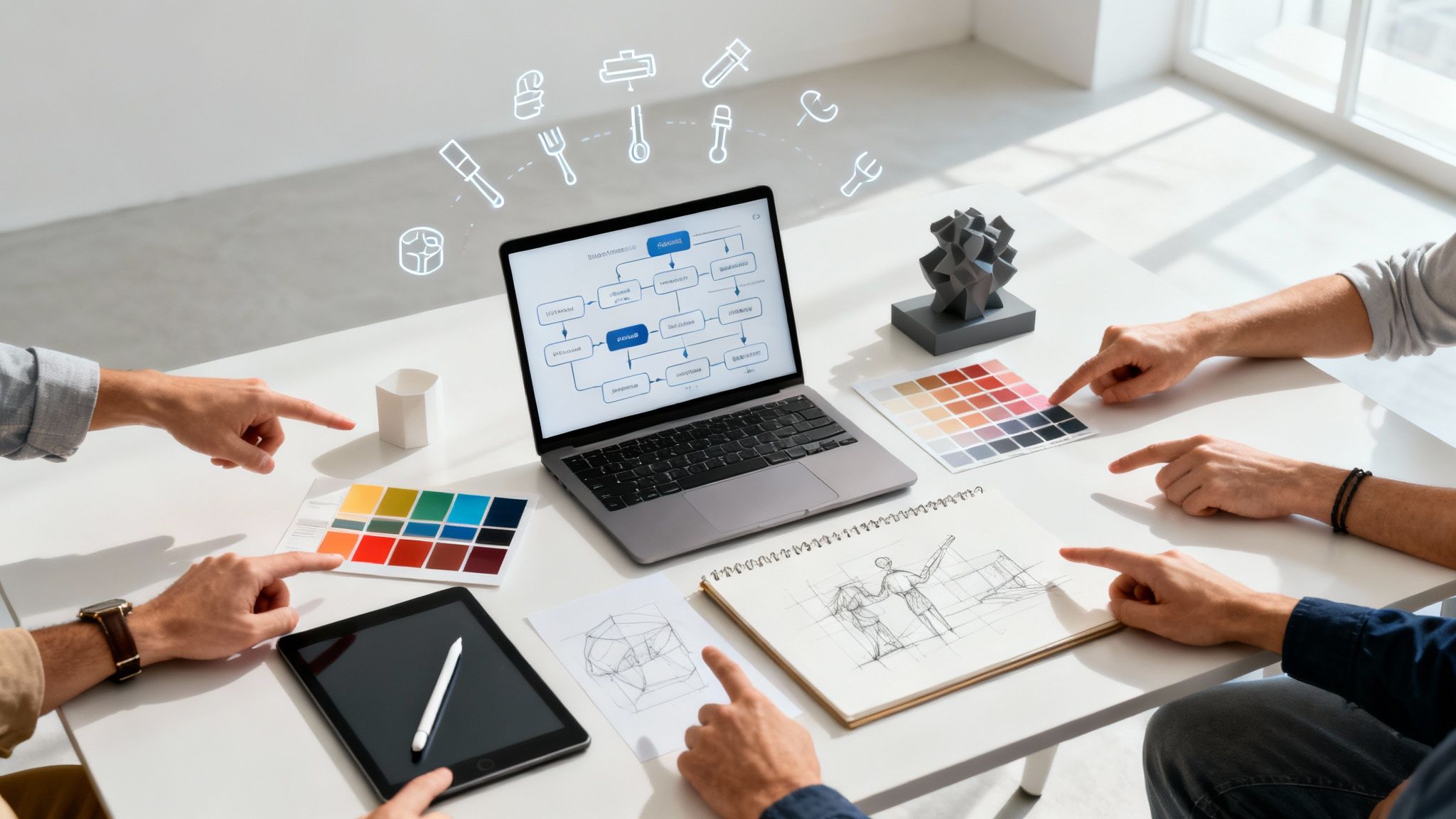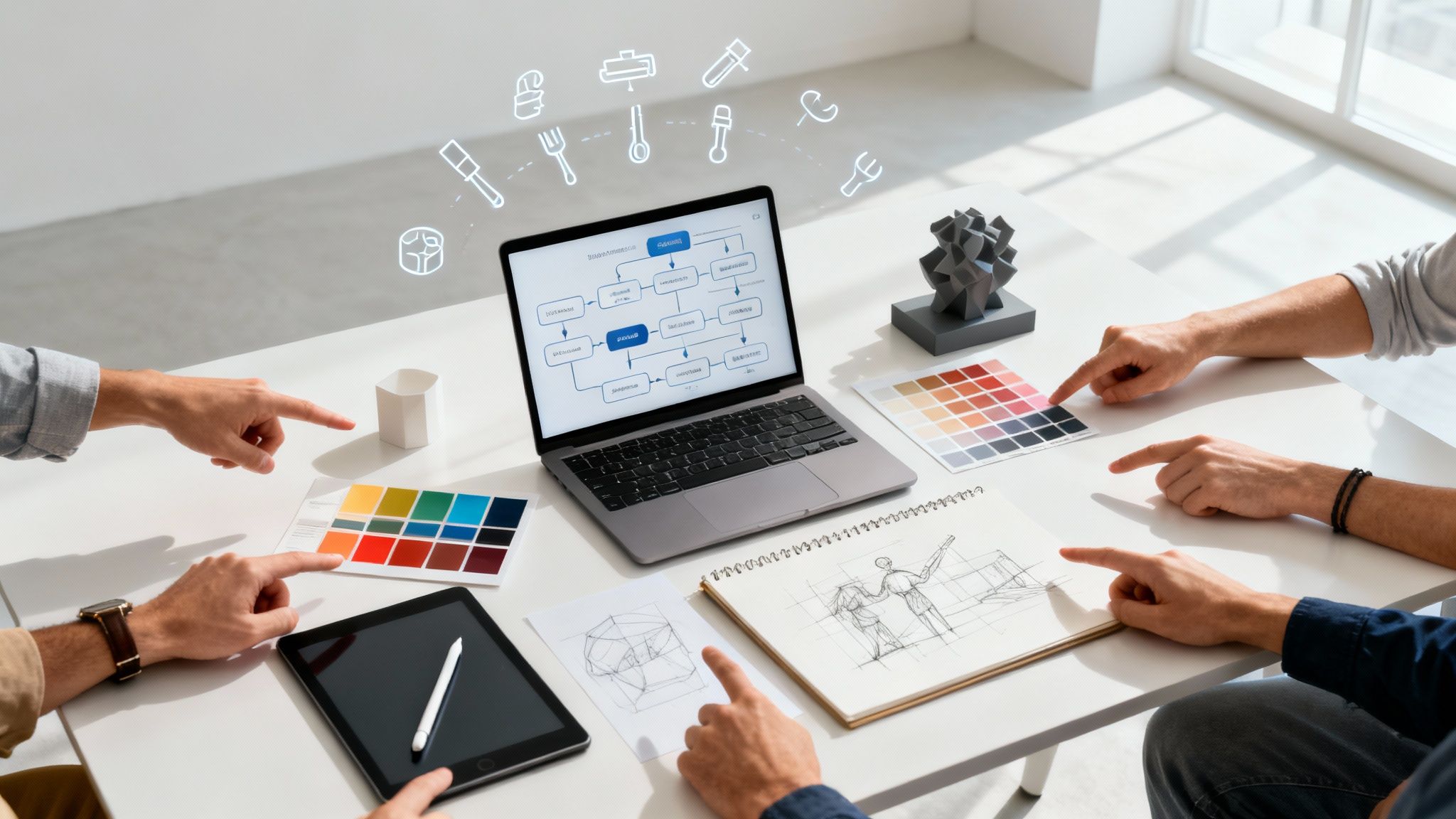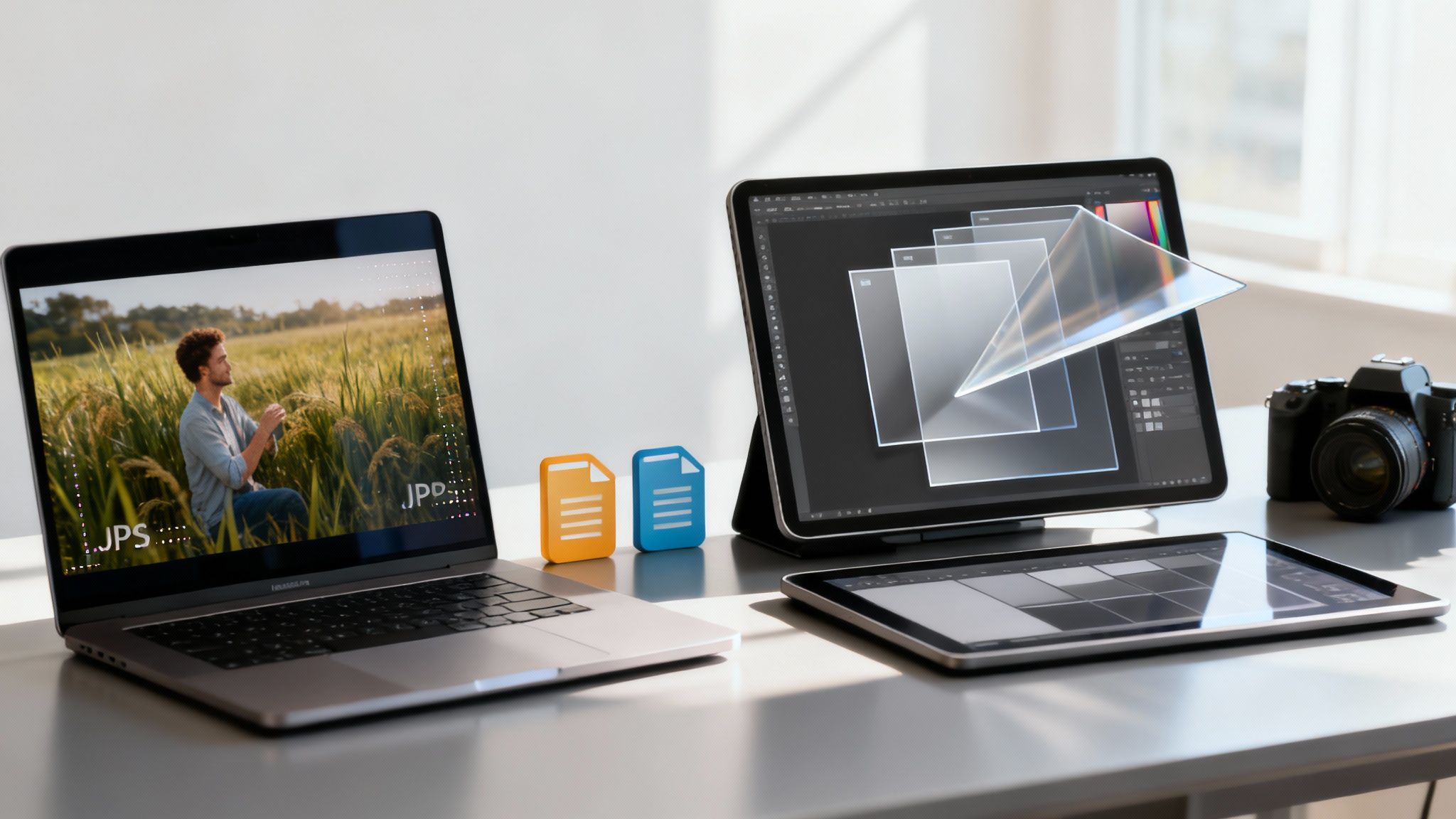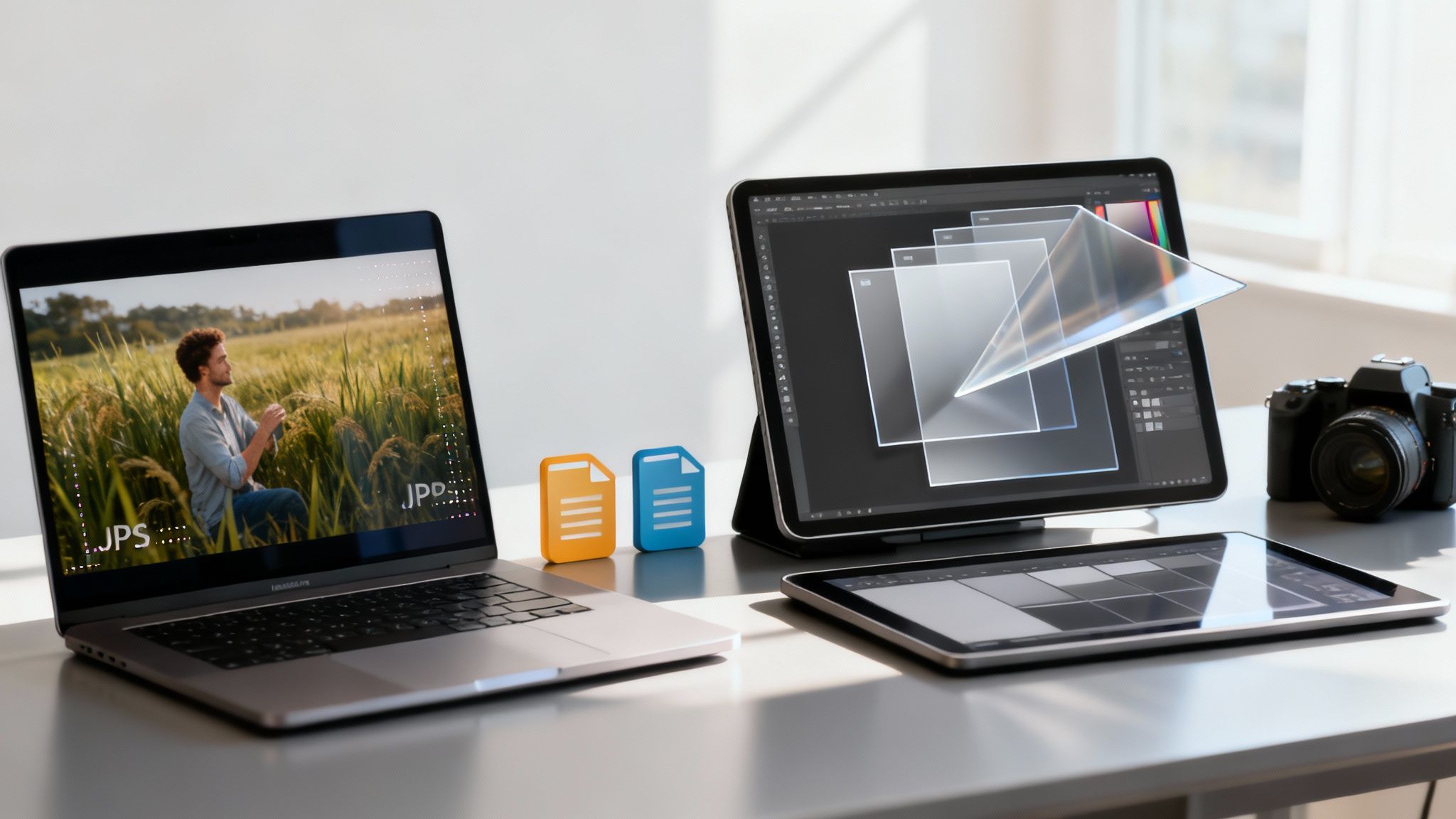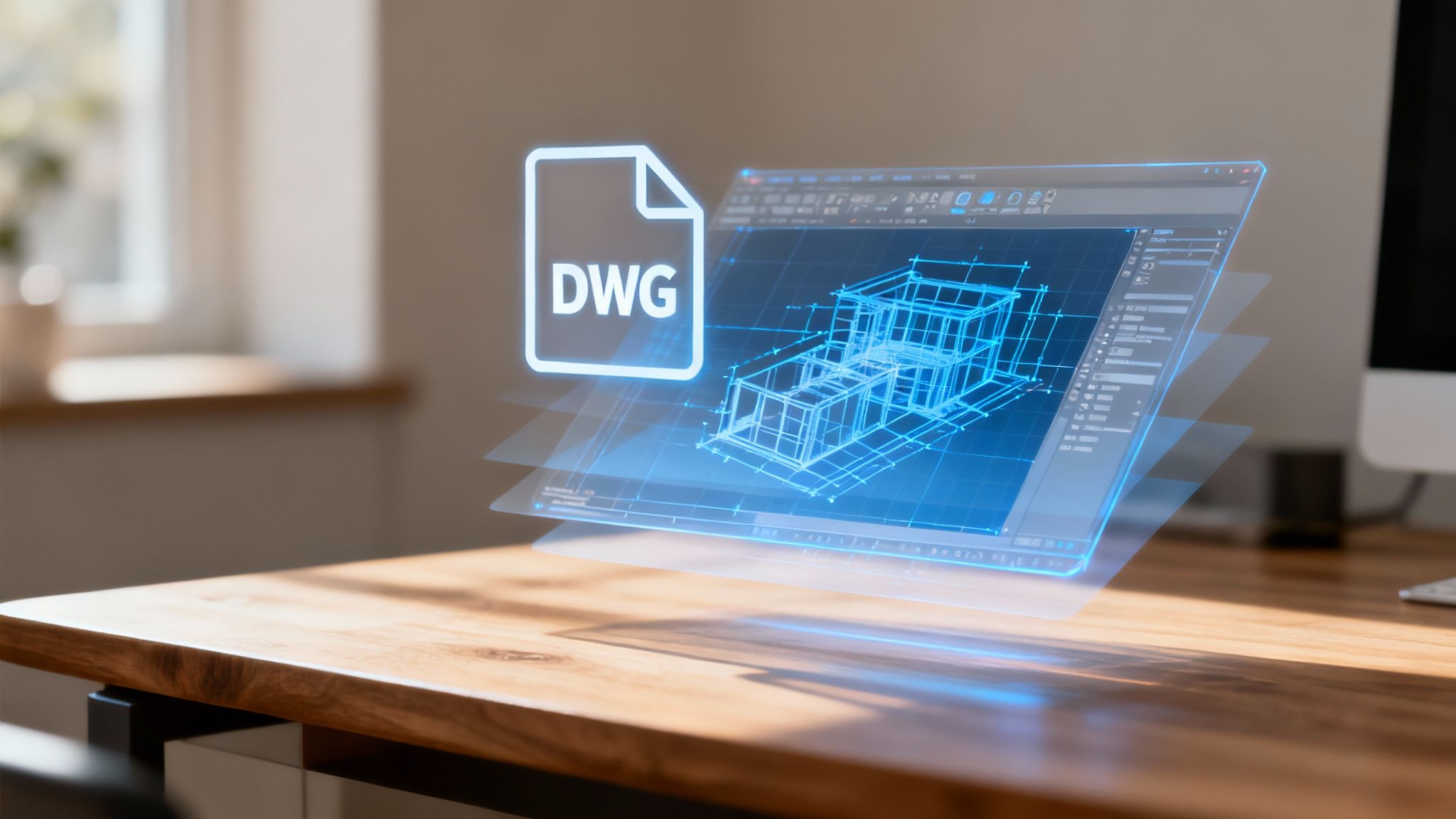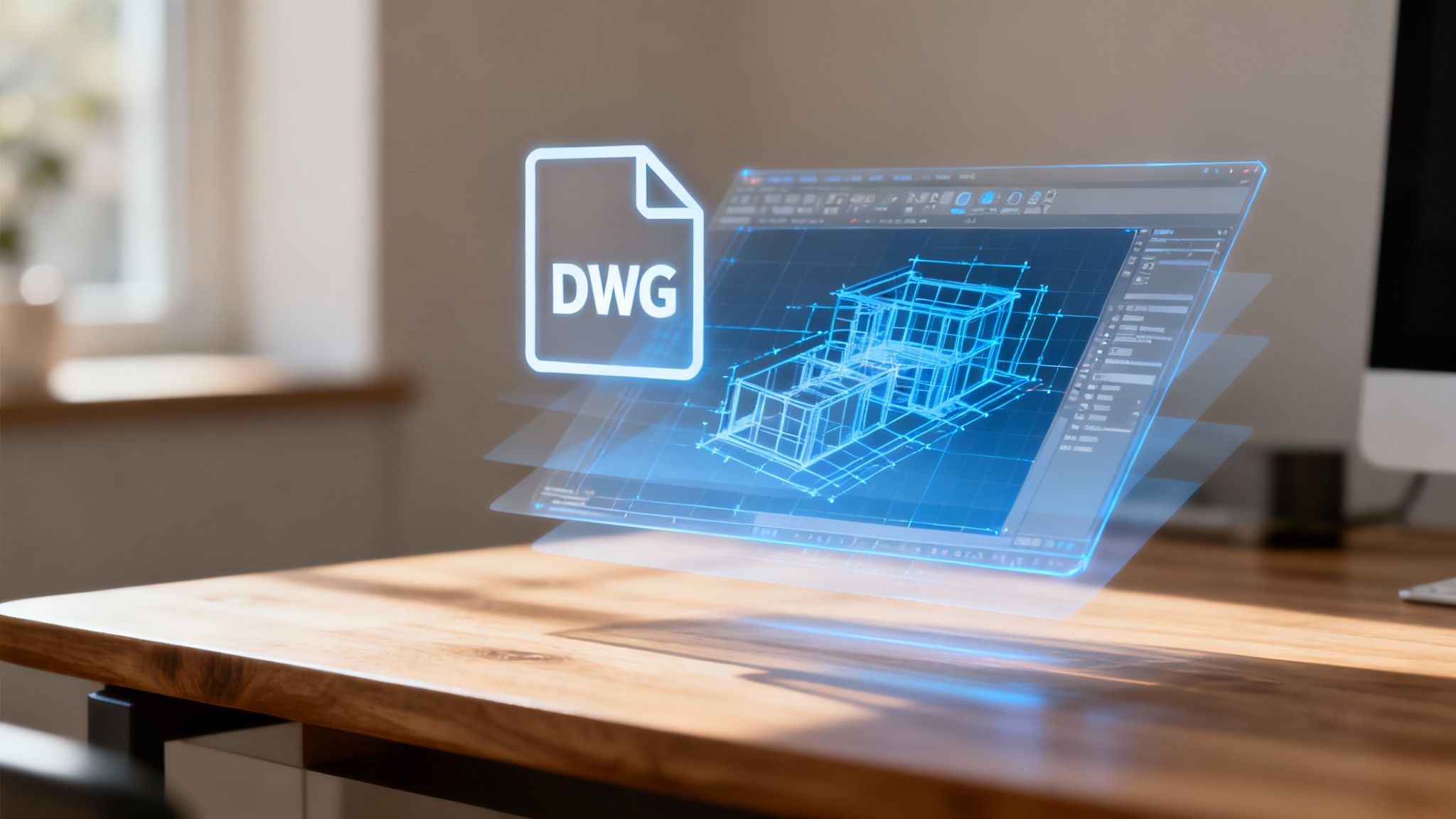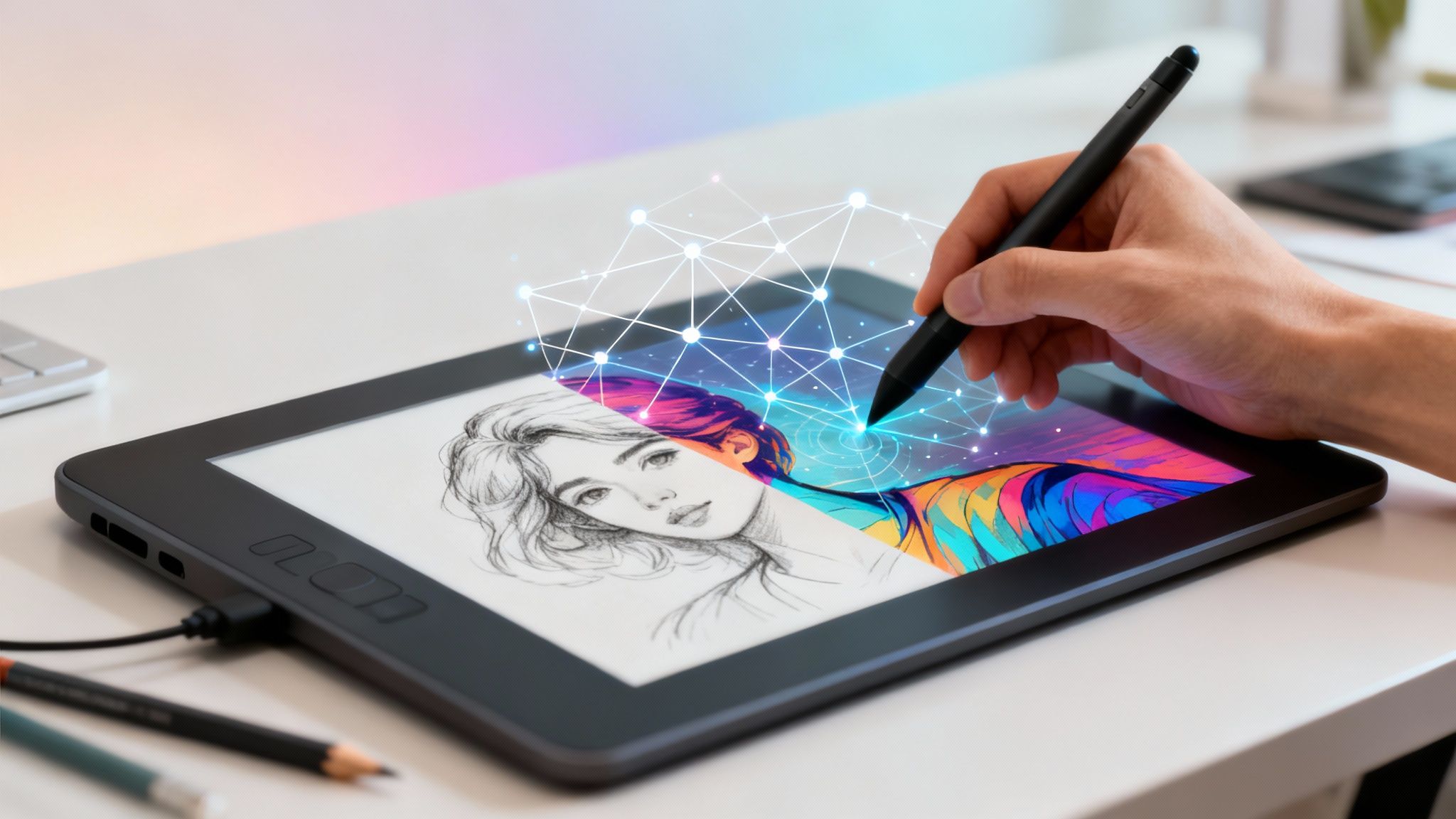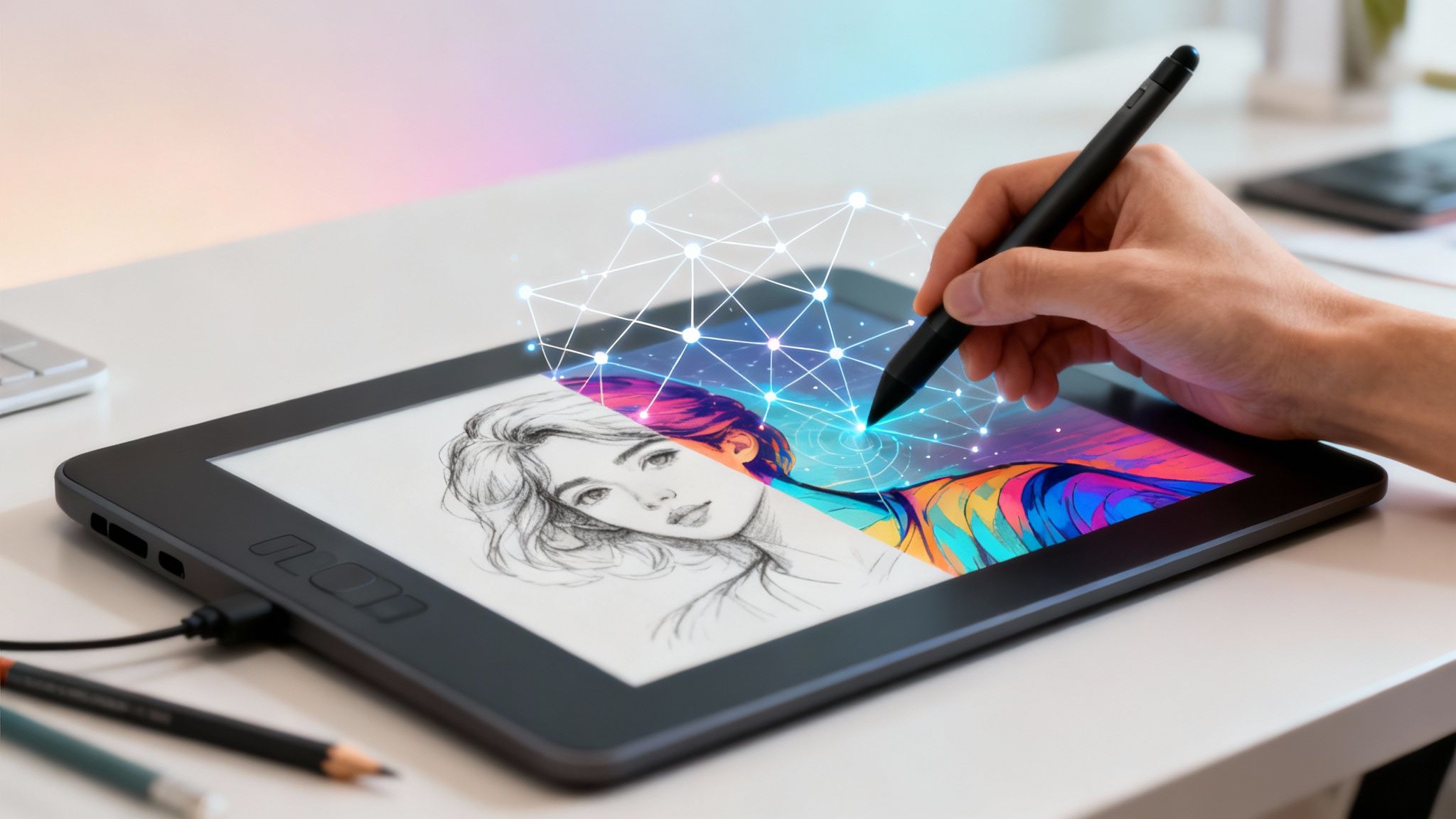In the fast-paced world of visual creative work, from 3D modelling to video production, seamless teamwork isn't just a bonus; it's the foundation of success. The challenge lies in harmonising individual talent with collective goals, ensuring every asset, from initial concept to final render, is managed securely and efficiently. This article outlines 10 crucial team collaboration best practices specifically tailored for creative and 3D design workflows.
These aren't just abstract ideas; they are actionable strategies designed to enhance productivity, foster innovation, and maintain the highest standards of compliance and security. By implementing these practices, your enterprise can build a resilient, scalable, and collaborative environment where creativity flourishes without compromising control. To begin transforming creative chaos into collaborative excellence, it is essential to first build a solid foundation by understanding the core of team collaboration and its foundational strategies.
Here, you will learn how to establish clear communication protocols, define precise roles, and create robust feedback loops that drive projects forward. We will explore how to organise workflows, break down departmental silos, and foster a psychologically safe environment where every team member can contribute their best work. Each practice is presented with practical implementation details to help you move from theory to tangible results.
1. Establish Unified Communication Protocols for Creative Assets
Generic communication rules often fall short for creative and 3D design teams where visual context is paramount. Establishing unified communication protocols means creating a standardised, predictable system for how your team discusses, critiques, and approves visual assets. This goes beyond just choosing a chat app; it involves defining precise channels, naming conventions, and feedback methods tailored to the creative lifecycle.
This foundational practice ensures that every stakeholder, from a 3D artist to a project manager, knows exactly where to find the latest feedback on a model or the final approved texture set. It eliminates ambiguity, prevents costly rework from missed comments, and is a cornerstone of a secure and compliant workflow by creating a clear, auditable trail of decisions.
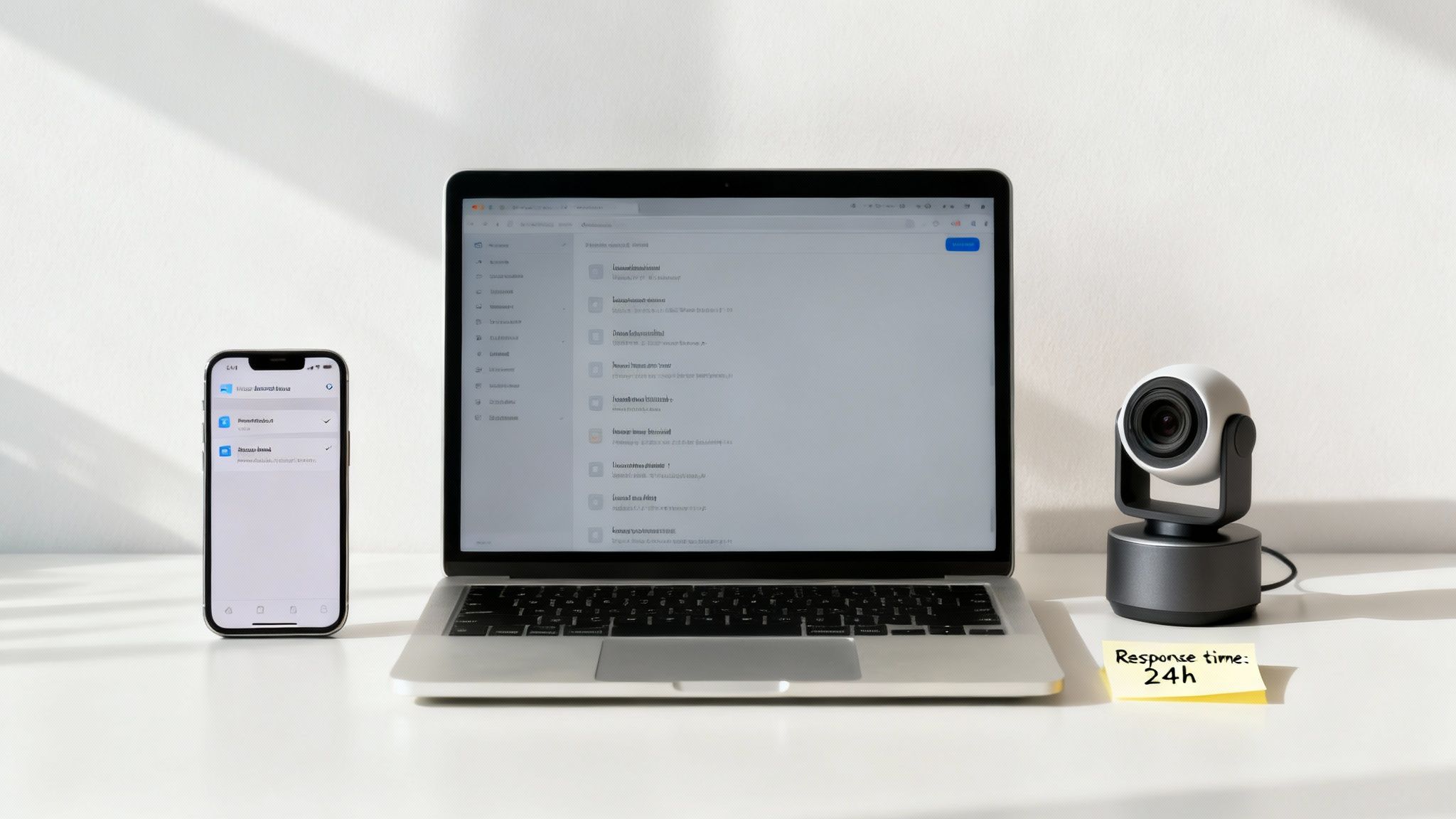
Why This Is a Top Team Collaboration Best Practice
Without dedicated protocols, feedback becomes scattered across emails, direct messages, and meeting notes, leading to version control chaos. For example, a crucial comment about a model's polygon count might be lost in a chat thread, while the official approval remains buried in an email chain. This disorganisation not only wastes time but also introduces significant security and compliance risks, as tracking asset history becomes nearly impossible. By centralising communication around the asset itself, you create a single source of truth.
How to Implement This Practice
- Create a Communication Playbook: Document your protocols in a central, easily accessible wiki (like Confluence or Notion). Define which channels are used for specific project phases: a Slack channel for initial brainstorming, a dedicated Microsoft Teams channel for a specific 3D asset's work-in-progress reviews, and a formal system for final sign-off.
- Standardise Naming and Versioning: Implement a strict naming convention for files (e.g.,
ProjectName_AssetName_v01_ArtistInitials.fbx). This simple step is vital for avoiding confusion and ensuring everyone works on the correct version. - Leverage Visual Annotation Tools: Use platforms that allow feedback directly on 3D models and images. Tools that enable drawing, commenting, and tagging specific parts of an asset make feedback unambiguous and actionable. This is far more effective than describing visual changes in text alone.
- Integrate Tools: Connect your communication platform with your digital asset management (DAM) or project management system. This creates a direct link between conversations and the specific asset files they relate to, solidifying your documentation process.
2. Defined Roles and Responsibilities
Clearly outlining each team member's accountabilities is essential for preventing duplicated effort, gaps in project coverage, and confusion over decision-making authority. For creative and 3D teams, this means explicitly defining who is responsible for modelling, who must be consulted on texturing, and who holds the final say on asset approval. This practice organises the creative process into a clear, predictable workflow.
This structural clarity is fundamental to a compliant and secure operation. When roles are well-defined, you create a transparent chain of command and an auditable record of who made key decisions and when. It moves your team from a state of ambiguous ownership to one of clear accountability, which is a critical element of effective team collaboration best practices.

Why This Is a Top Team Collaboration Best Practice
Without defined roles, projects often stall. For instance, two artists might unknowingly work on the same environment asset, wasting valuable hours, while a critical character model is neglected because no one was assigned clear ownership. This ambiguity not only kills efficiency but also introduces compliance risks, as it becomes difficult to track who had the authority to approve a final asset for production, creating a weak link in your quality assurance and sign-off process.
How to Implement This Practice
- Create a RACI Chart: Use a Responsible, Accountable, Consulted, and Informed (RACI) matrix for each major project milestone. This simple chart clarifies exactly who does the work, who owns the outcome, who provides input, and who just needs to be kept in the loop.
- Develop Role Templates: Document standard roles within your team (e.g., Lead 3D Artist, Junior Animator). For each template, define the scope, key performance indicators (KPIs), and decision-making authority, ensuring everyone understands their mandate.
- Document Decision-Making Frameworks: Don't just assign roles; specify how decisions are made within those roles. For example, define the criteria a Senior Artist should use to approve a model before it moves to the texturing phase.
- Conduct Regular Role Reviews: Revisit roles and responsibilities during quarterly planning sessions or project retrospectives. As projects evolve and teams change, these definitions must be updated to remain relevant and effective.
3. Regular Synchronous Meetings
While asynchronous communication is crucial for deep work, scheduled synchronous meetings provide essential touchpoints for alignment, real-time problem-solving, and team cohesion. Regular meetings like daily stand-ups, weekly check-ins, and sprint reviews create a predictable rhythm for the team. They offer dedicated time for live discussions that are often inefficient over text, particularly when nuances in creative feedback are involved.
This practice is key to maintaining momentum and building interpersonal relationships, especially in remote or hybrid environments. For creative teams, these sessions are invaluable for brainstorming, unblocking complex visual problems, and ensuring everyone shares the same vision for an asset or project. They also reinforce accountability and provide a structured forum for raising concerns, which is vital for a healthy and productive team dynamic.

Why This Is a Top Team Collaboration Best Practice
Without structured, real-time check-ins, teams can quickly become siloed. A texture artist might spend days working in a direction that misinterprets feedback, a problem that a quick five-minute conversation could have solved. These meetings act as a safety net, catching misunderstandings early and ensuring projects stay on track. They are fundamental to agile methodologies and keep teams synchronised and focused on immediate goals. For a deeper dive into platforms that enable this, explore these real-time collaboration tools on virtuall.pro.
How to Implement This Practice
- Establish a Clear Cadence: Schedule recurring meetings at consistent times. A daily stand-up at 9:15 AM, a weekly review on Wednesdays, and a sprint planning session every other Monday creates a reliable structure that team members can plan their work around.
- Set and Share Agendas: For any meeting longer than a stand-up, circulate a clear agenda at least 24 hours in advance. This allows participants to prepare, ensuring the conversation is focused and respects everyone's time.
- Keep Stand-ups Short and Structured: Limit daily stand-ups to 15 minutes. Use a simple format: what I did yesterday, what I am doing today, and any blockers I am facing. This keeps the meeting concise and action-oriented.
- Use Video to Build Connection: Encourage cameras-on during meetings, especially for remote teams. Visual cues are a powerful part of communication and help foster stronger team bonds and a more inclusive environment.
4. Transparent Documentation and Knowledge Sharing
Relying on individual team members as the sole keepers of critical project knowledge is a significant operational risk. Transparent documentation involves creating a centralised, accessible knowledge base that captures everything from process guidelines and decision records to technical best practices. This system ensures that valuable institutional knowledge is retained, even when team members move on, and drastically reduces time spent on repetitive questions.
This practice is essential for scaling creative teams and maintaining consistency across complex projects. For a 3D pipeline, this could mean documenting material shader settings, export specifications for a game engine, or the rationale behind an art direction choice. A robust knowledge base is a hallmark of a mature, organised, and secure operational model, providing a clear reference point for both new and veteran team members.

Why This Is a Top Team Collaboration Best Practice
When documentation is an afterthought, teams suffer from "knowledge silos," where crucial information is lost in private chats or individual hard drives. A new artist might waste days trying to replicate a lighting setup that a former colleague had perfected, simply because it was never written down. Radical transparency in documentation empowers teams to operate autonomously and efficiently. This organised approach is not just about efficiency; it's a key component of a compliant and auditable workflow.
How to Implement This Practice
- Create a Central Wiki: Use a tool like Notion, Confluence, or a simple shared document system to build a single source of truth. Organise it by project, discipline (e.g., "3D Modelling Standards"), or process.
- Assign Documentation Owners: Make specific individuals responsible for maintaining certain sections of the documentation. This ensures information stays current and accurate.
- Use Templates: Standardise your documentation by creating templates for common documents like project kick-off briefs, asset creation guidelines, and after-action reviews.
- Schedule Regular Reviews: Set aside time quarterly to review, update, and archive outdated documents. Mark every document with a "last updated" date to show its relevancy.
- Integrate with Asset Management: A strong documentation culture is a perfect complement to a well-structured asset library. Learn more about how to organise your digital assets on virtuall.pro to create a fully cohesive system.
5. Cultivate Psychological Safety and an Inclusive Environment
Creating an environment where team members feel safe to speak up, take creative risks, and challenge ideas without fear of negative consequences is fundamental to innovative design. Psychological safety isn't about being nice; it's about fostering a culture of candour where diverse perspectives are actively sought and valued. This is one of the most critical team collaboration best practices for creative and 3D workflows, where experimentation and iteration are essential.
This practice directly impacts a team's ability to innovate and problem-solve. In a psychologically safe space, an artist is more likely to suggest an unconventional modelling technique or point out a potential flaw in a pipeline early on. This prevents groupthink, encourages ownership, and ultimately leads to higher-quality creative output and a more resilient, engaged team. A culture built on trust is a secure culture.
Why This Is a Top Team Collaboration Best Practice
Without psychological safety, teams operate in a state of fear. Mistakes are hidden, feedback is withheld, and brilliant but "risky" ideas are never voiced. This stifles creativity and can lead to significant project failures that could have been avoided. For instance, a junior artist might notice a critical texturing error but stay silent for fear of looking incompetent, leading to costly rework later. By establishing safety, you unlock the full collective intelligence of your team, making honest critique a tool for growth rather than a source of conflict.
How to Implement This Practice
- Model Vulnerability from the Top: Leaders should openly admit their own mistakes and knowledge gaps. When a director says, "I was wrong about that approach, let's try your idea," it signals that it's safe for others to do the same.
- Implement Blameless Post-mortems: After a project milestone or a failure, conduct reviews focused on process, not people. The goal is to understand what went wrong and how to improve, not who was at fault.
- Establish Inclusive Critique Sessions: Structure feedback sessions where critiques are directed at the work, not the individual. Ensure everyone has an opportunity to contribute their thoughts without interruption.
- Actively Solicit Dissenting Opinions: During key decisions, explicitly ask, "What are we missing?" or "What is the argument against this?" This normalises constructive conflict and helps uncover blind spots in creative or technical planning.
6. Embrace Asynchronous Work Practices
Asynchronous work practices enable collaboration that doesn’t demand simultaneous participation from all team members. By prioritising documented decisions, written updates, and thoughtful communication, this approach allows distributed creative teams and individuals with different work styles to contribute effectively without being constrained by time zones or meeting schedules. This is especially vital for global 3D production pipelines where artists and stakeholders are spread across continents.
This method fosters a culture of deep work and autonomy. It ensures that progress isn't halted waiting for a real-time meeting to approve a texture or provide feedback on a model. Instead, information is shared with full context, allowing team members to engage when they are most productive, leading to more considered and higher-quality contributions. This documented approach also enhances security and compliance by creating clear, time-stamped records of all project communications and decisions.
Why This Is a Top Team Collaboration Best Practice
A reliance on real-time, synchronous meetings often creates bottlenecks, especially in creative workflows that require focused concentration. An urgent request for feedback can interrupt an artist's flow state, while differing time zones can mean days of delay. Asynchronous communication solves this by building a more efficient, inclusive, and resilient system. It respects individual workflows and empowers team members to manage their time effectively, reducing burnout and improving overall productivity and creative output.
How to Implement This Practice
- Document Everything with Context: When making a request or sharing an update, provide comprehensive background information. Instead of a vague "What's the status on the dragon model?", write a detailed comment: "Reviewing
Dragon_Model_v03_Texture_Pass_01.fbx. The scales on the wings lack the iridescence shown in the concept art. Please see attached reference and update before EOD tomorrow." - Utilise Threaded Discussions: Keep conversations organised by using threads in your communication tools. This ensures all feedback and decisions related to a specific asset or task are grouped together, creating a clean, auditable trail.
- Record and Share Explanations: For complex visual feedback or technical instructions, record a short video (e.g., using Loom or OBS) where you walk through the 3D model or asset. This is often clearer and faster than typing out long paragraphs.
- Set Clear Deadlines for Feedback: Asynchronous doesn't mean "whenever". Set explicit deadlines for feedback and decisions to keep projects moving. This practice can be effectively managed using tools like a Kanban board for project management.
7. Define Shared Outcomes with Goal Alignment and OKRs
Creative projects can easily lose focus without a clear, shared vision of success. Implementing a goal-setting framework like Objectives and Key Results (OKRs) aligns team efforts towards measurable outcomes, ensuring every texture, model, and animation directly contributes to a larger strategic purpose. This methodology moves teams from simply being busy to being productive in a focused, purposeful direction.
This practice is crucial for maintaining momentum and morale, as it provides a transparent roadmap showing how individual contributions, such as an artist finalising a character model, connect to a major team objective like launching a new game level. It fosters a results-oriented culture, reduces wasted effort on non-essential tasks, and creates a clear, documented framework for tracking progress against high-level business goals.
Why This Is a Top Team Collaboration Best Practice
Without aligned goals, team members may work diligently on tasks that are ultimately misaligned with project priorities. An animator might spend weeks perfecting a sequence that gets cut, or a 3D modeller could over-invest time in an asset deemed low-priority. OKRs prevent this by making priorities explicit and public. This clarity is a fundamental part of effective team collaboration best practices, ensuring that all creative energy is channelled toward what truly matters, fostering both efficiency and a sense of shared accomplishment.
How to Implement This Practice
- Establish Ambitious Objectives: Define 3-5 high-level, inspirational objectives for a given period (e.g., a quarter). An objective should answer the question, "What do we want to achieve?" For example, "Launch a visually stunning and bug-free game trailer."
- Set Measurable Key Results: For each objective, define 3-5 specific, measurable key results that track progress. For the trailer objective, a key result could be "Achieve a 95% performance benchmark on target hardware" or "Finalise all character animation cycles with less than 5% revision rate."
- Maintain Visibility and Regular Reviews: Use collaborative tools to keep OKRs visible to the entire team. Hold weekly or bi-weekly check-ins to discuss progress, identify blockers, and adjust tactics. This regular cadence keeps the goals top-of-mind.
- Link Individual and Team Goals: Encourage team members to set their own goals that directly support the team’s OKRs. This connection helps everyone see how their personal work drives the collective mission forward and fosters a strong sense of ownership.
8. Foster Constructive Feedback Loops
Fostering constructive feedback loops means establishing regular, structured opportunities for critique and praise. For creative and 3D teams, this moves beyond annual reviews to a continuous culture of improvement where feedback is timely, specific, and aimed at elevating the quality of the work and the skills of the team. This practice involves both formal design reviews and informal check-ins, creating a safe environment where artists and designers can address issues early and feel valued.
This approach is a core component of high-performing team collaboration best practices. It prevents small misunderstandings from escalating into major design flaws and ensures creative output is constantly refined. By normalising feedback, you build a resilient team that views critique not as personal criticism, but as an essential part of the collaborative process, which is vital for security and accountability in a traceable workflow.
Why This Is a Top Team Collaboration Best practice
Without structured feedback loops, input becomes either non-existent or emotionally charged, leading to defensiveness and creative stagnation. A 3D artist might spend weeks on a character model, only to receive vague, last-minute feedback that forces extensive rework. This erodes morale and project timelines. A well-organised feedback system ensures that challenges are addressed with care and precision, building trust and accelerating project velocity.
How to Implement This Practice
- Schedule Regular Feedback Sessions: Implement a predictable rhythm for feedback, such as daily stand-ups for quick check-ins and weekly sessions for more in-depth critiques of visual assets. This makes feedback a normal, expected part of the workflow.
- Use the 'SBI' Framework: Train your team to give feedback using the Situation-Behaviour-Impact model. For example, "In yesterday's review (Situation), you presented the texture variants without context (Behaviour), which made it difficult for the team to make a decision (Impact)." This keeps the feedback objective.
- Encourage Peer-to-Peer Feedback: Don't limit feedback to a top-down model. Create opportunities for artists to give and receive input from their peers, as they often have the most relevant and practical insights.
- Balance Constructive and Positive Input: To ensure feedback loops are both rhythmic and constructive, focus on providing specific and impactful positive reinforcement. Explore some powerful positive feedback examples to build morale and highlight what the team is doing right.
9. Cross-Functional Collaboration and Breaking Silos
In complex creative projects, departments can easily become isolated, leading to disconnected workflows and misaligned final products. Cross-functional collaboration is the practice of intentionally breaking down these departmental silos by creating teams with members from different disciplines, such as 3D art, marketing, engineering, and quality assurance. This model fosters a shared understanding of the entire project lifecycle, not just one part of it.
This approach ensures that technical constraints are considered during the creative phase and that marketing needs inform asset creation from the start. For creative and 3D design teams, this means a 3D model is built not only to be visually stunning but also performant in the game engine and suitable for promotional materials. This holistic view is a key team collaboration best practice that accelerates innovation and reduces friction.
Why This Is a Top Team Collaboration Best Practice
When teams operate in silos, critical information gets lost in translation between departments. For instance, a 3D artist might create a high-polygon model that looks incredible but is unusable for the engineering team due to performance limitations, forcing costly and time-consuming rework. By integrating teams, potential issues are identified and solved early. This proactive problem-solving leads to higher-quality outcomes, faster development cycles, and a more cohesive final product.
How to Implement This Practice
- Form Project-Specific Squads: For major initiatives, assemble dedicated teams with representatives from every relevant discipline to give teams ownership and autonomy over their part of the project.
- Establish Shared KPIs: Define key performance indicators that require input from multiple departments to succeed. For example, a shared KPI could be "Time from asset concept to in-engine implementation," which holds both art and engineering accountable.
- Facilitate Cross-Disciplinary Learning: Organise regular "lunch-and-learn" sessions where a member from one department presents their workflow, tools, and challenges to others. This builds empathy and understanding across different roles.
- Celebrate Joint Successes: When a cross-functional team achieves a milestone, celebrate it publicly. Highlighting these joint wins reinforces the value of collaboration and encourages teams to break out of their departmental comfort zones.
10. Continuous Learning and Skill Development
Fostering a culture of continuous learning means actively investing in your team's professional growth beyond their immediate project tasks. For creative and 3D design teams, where software and techniques evolve at a blistering pace, this isn't a perk; it's a strategic necessity. It involves creating structured opportunities for skill enhancement, from formal training on new rendering engines to peer-led workshops on efficient UV mapping.
This commitment ensures your team’s capabilities keep pace with industry demands, boosting innovation and output quality. Prioritising development signals that you value your team as long-term assets, which improves morale and retention. It also reinforces a secure and compliant workflow, as well-trained teams are more adept at using tools correctly and adhering to the latest security protocols.
Why This Is a Top Team Collaboration Best Practice
A team that isn't learning is a team that's falling behind. Stagnant skills lead to outdated workflows, reduced efficiency, and an inability to leverage new technologies that could provide a competitive edge. For instance, a 3D artist unfamiliar with the latest real-time rendering software may spend days on a task that a trained colleague could complete in hours. By institutionalising learning, you build a more resilient, capable, and forward-thinking creative unit.
How to Implement This Practice
- Allocate a Dedicated Learning Budget: Formally assign a budget for each team member's professional development (e.g., £1,200-£2,000 per year) for courses, certifications, and conferences. This makes learning an official and trackable part of their role.
- Establish Formal Mentorship Programmes: Pair junior artists with senior leads to facilitate knowledge transfer. Structure the programme with clear goals and regular check-ins to ensure both mentor and mentee benefit from the relationship.
- Host Internal Knowledge-Sharing Sessions: Organise monthly "lunch and learns" or peer-led workshops where team members can present new techniques, software tips, or project post-mortems. This is a cost-effective way to circulate expertise.
- Connect Learning to Career Progression: Integrate skill development goals into performance reviews and link them directly to career pathways. This shows a clear return on investment for the employee's time and effort, motivating them to engage actively.
10-Point Team Collaboration Best Practices Comparison
Building Your Creative Operating System
The journey from a collection of talented individuals to a high-performing, unified creative team is not accidental. It is a deliberate process built on a foundation of clear, consistent, and effective team collaboration best practices. The principles we have explored, from establishing crystal-clear communication protocols and defined roles to fostering psychological safety and implementing robust feedback loops, are not just isolated tactics. They are interconnected components of a comprehensive creative "operating system" for your studio. This system is what enables your team to navigate the complexities of 3D design, game development, and other demanding creative workflows with agility and confidence.
From Principles to Practice
Adopting these practices means transforming abstract goals into daily habits. It is about moving beyond simply having talented artists and designers to creating an environment where their combined efforts produce something greater than the sum of its parts. When you centralise documentation, align everyone on shared goals using OKRs, and champion both synchronous and asynchronous work, you reduce friction and eliminate ambiguity. This clarity allows creativity to flourish, as team members can focus their energy on innovation and execution rather than on deciphering processes or chasing down information.
The true power of mastering these team collaboration best practices lies in their cumulative effect.
- Enhanced Efficiency: Clear roles and asynchronous workflows minimise delays and bottlenecks, accelerating project timelines.
- Improved Quality: Constructive feedback loops and cross-functional collaboration lead to more refined, well-rounded, and innovative final products.
- Increased Agility: A well-organised, transparent system allows your team to adapt quickly to changing project requirements or market demands.
- Stronger Team Cohesion: Fostering an inclusive and psychologically safe environment boosts morale, reduces turnover, and builds a resilient, supportive team culture.
A Secure Foundation for Creative Excellence
Ultimately, building this operating system is an investment in your team's long-term success and sustainability. It creates a scalable framework that supports growth, simplifies onboarding, and ensures that your creative output remains consistently high. By thoughtfully integrating these principles into your daily operations, you are not just optimising a workflow; you are cultivating an ecosystem where your team can produce its most groundbreaking work securely and efficiently. This commitment to structured collaboration is what separates good creative teams from truly exceptional ones, establishing a powerful competitive advantage in a fast-paced industry.
Ready to build your team's creative operating system? Discover how Virtuall unifies asset management, feedback, and project workflows into a single, secure platform designed for modern creative teams. See how you can implement these team collaboration best practices with ease by visiting Virtuall.

